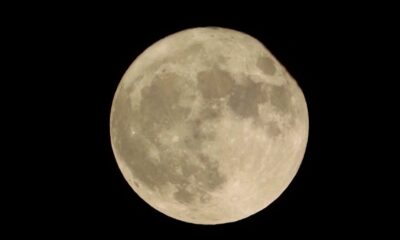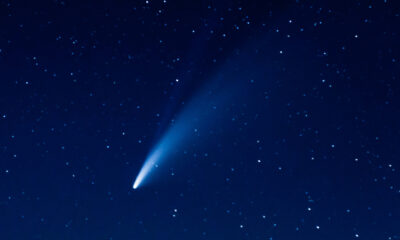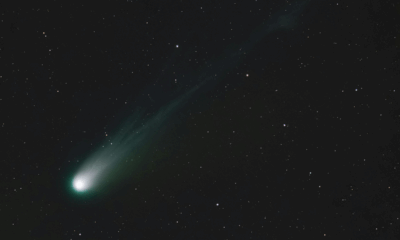Science
Harvard Scientist Proposes Antimatter Composition for Comet 3I/ATLAS

The scientific community is abuzz following a provocative claim by Harvard astrophysicist Avi Loeb, who suggests that the interstellar comet 3I/ATLAS may be composed of antimatter. This assertion could have significant implications, as antimatter annihilates normal matter, releasing vast amounts of energy. In an article published on Medium, Loeb referred to antimatter as “the most efficient fuel” in the universe, proposing that if 3I/ATLAS contains this rare substance, it might produce detectable gamma-ray or X-ray emissions as it moves through the solar wind.
Loeb emphasized that his theory is intended for educational purposes, but it has sparked renewed interest in the possibility that this cosmic object is more than just a typical comet. He pointed out that an antimatter body traversing the Solar System would represent an extraordinarily efficient energy source, suggesting a technological origin.
Discovery and Characteristics of 3I/ATLAS
3I/ATLAS, officially designated C/2025 N1, was discovered on July 1, 2025, by the Asteroid Terrestrial-impact Last Alert System (ATLAS) in Hawaii. It is noteworthy for being only the third confirmed interstellar visitor to enter the Solar System, following ʻOumuamua in 2017 and 2I/Borisov in 2019. According to EarthSky, 3I/ATLAS has an orbit inclined at 175° to the ecliptic, positioning it within approximately 5° of the plane of the Solar System’s planets.
Observations reported by The Economist indicated that as the comet approached its closest point to the Sun, it appeared “bluer than the Sun.” Loeb interpreted this coloration as possible evidence of internal energy generation rather than simply reflecting sunlight. Additionally, he noted the comet exhibited non-gravitational acceleration, hinting at another force acting upon it. In an interview cited by Newsweek, Loeb remarked that this phenomenon “could indicate propulsion or an energy source other than sunlight,” though he refrained from asserting it as proof of extraterrestrial design.
Implications of Antimatter Presence
In his Medium essay, Loeb argued that if 3I/ATLAS is indeed composed of antimatter, annihilation with solar particles could explain its unusual acceleration and luminescence. He stated, “The mix of matter and antimatter offers the most efficient fuel,” highlighting that “complete mass-to-energy conversion is unmatched by any chemical or nuclear reaction.” Despite this, he acknowledged the extreme rarity and instability of antimatter, estimating that producing just one gram on Earth would cost approximately $5 quadrillion. This underscores the challenges associated with its existence.
While Loeb’s hypothesis may seem to drift into science fiction, he maintains that it is “testable” through future observations, particularly by monitoring for high-energy emissions or unusual spectral signatures as 3I/ATLAS continues its trajectory through the inner Solar System. Despite the allure of these possibilities, skepticism from mainstream scientists remains strong. Dr. Samantha Lawler, an astrophysicist at the University of Regina in Canada, stated, “Extraordinary claims require extraordinary evidence, and the evidence presented is absolutely not extraordinary.”
NASA has also weighed in, noting that 3I/ATLAS “behaves like a natural comet in all observable ways” and that there is no credible evidence to suggest an artificial or exotic composition. Furthermore, astronomers point out that non-gravitational accelerations are a common occurrence among comets, typically caused by sunlight heating their surfaces and generating gas jets that can slightly alter their courses. Cosmologists argue that significant concentrations of antimatter in the universe are ruled out by gamma-ray observations, as detailed in studies published on arXiv. Even Loeb acknowledged that substantial antimatter bodies would likely have been destroyed shortly after the Big Bang.
Despite the prevailing doubts, there is consensus among scientists that 3I/ATLAS merits continued observation. Teams globally are set to monitor its brightness, tail development, and trajectory to determine whether the anomalies cited by Loeb are persistent or can be explained by conventional physics. In a separate post titled “Should We Be Happier if 3I/ATLAS Is a Comet?”, Loeb expressed that even if the object turns out to be entirely natural, “we should still celebrate, because nature continues to surprise us without needing aliens or antimatter.”
As 3I/ATLAS moves away from the Sun, the discussions it has ignited highlight the limited understanding of interstellar materials passing through our cosmic neighborhood and the extent to which astronomers are willing to explore imaginative explanations in their quest for knowledge.
-

 Entertainment3 months ago
Entertainment3 months agoAnn Ming Reflects on ITV’s ‘I Fought the Law’ Drama
-

 Entertainment4 months ago
Entertainment4 months agoKate Garraway Sells £2 Million Home Amid Financial Struggles
-

 Health3 months ago
Health3 months agoKatie Price Faces New Health Concerns After Cancer Symptoms Resurface
-

 Entertainment3 months ago
Entertainment3 months agoCoronation Street’s Carl Webster Faces Trouble with New Affairs
-

 Entertainment3 months ago
Entertainment3 months agoWhere is Tinder Swindler Simon Leviev? Latest Updates Revealed
-

 Entertainment4 months ago
Entertainment4 months agoMarkiplier Addresses AI Controversy During Livestream Response
-

 Science1 month ago
Science1 month agoBrian Cox Addresses Claims of Alien Probe in 3I/ATLAS Discovery
-

 World2 weeks ago
World2 weeks agoBailey Announces Heartbreaking Split from Rebecca After Reunion
-

 Health4 months ago
Health4 months agoCarol Vorderman Reflects on Health Scare and Family Support
-

 Entertainment4 months ago
Entertainment4 months agoKim Cattrall Posts Cryptic Message After HBO’s Sequel Cancellation
-

 Entertainment3 months ago
Entertainment3 months agoOlivia Attwood Opens Up About Fallout with Former Best Friend
-

 Entertainment2 weeks ago
Entertainment2 weeks agoCoronation Street Fans React as Todd Faces Heartbreaking Choice





















